Asia’s latest Instagram bait – Waka Haiku Setsugekka Japanese Restaurant – by Sun Tianwen of Shanghai design studio: Hip-Pop Architectural Decoration Design Co. (HPADDC) points to hospitality further heading toward the sensory and experiential path of its retail sister.

Waka Haiku Setsugekka Japanese Restaurant, Hip-Pop Architectureal Decoration Design Co, China, Asia Pacific Design, Hospitality design
Much like the retail sector, hospitality design is becoming increasingly sensory; spaces that encourage a tactile, engaging experience built around hype and spectacle. But hospitality is a fairly different beast, where the typology has become not just a transactional space, but one for working, living and playing. This hybrid functionality obviously has huge implications for designers who are charged with delivering spaces that are simultaneously three or four sectors combined.
In his recent design of the Setsugekka Japanese Restaurant in Changchun’s Jilin Province, HPADDC’s Chief Architect Sun Tianwen produces several smaller design elements, which only when combined “mix harmoniously for the appropriate design and conceptual tounchpoints.”
Individually for example, the ultra-clear glass engraved with the Sakura, the blue LED light band and the complete black background of the sushi counter do not necessarily express the sense of “Zen” — however, when each of these elements come together as a whole, then an appropriate design is obtained.
Perhaps one of the most important factors of Tiawen’s approach is his study of the psychology of design. Sure – design psychology is one of those wafty, undefined “easy-target” industry jokes that either designates you as a “snob” or a “novice”. But when you really look into what the term is, it’s about researching and mapping the data of how and why we use and behave within particular settings.
Here, the design approach was to communicate the restaurant’s themes of zen and more importantly “setsugekka” – meaning “Snow Moon Flower”, a Japanese topic in art and design borrowed from old-world China. Setsugekka is an important aspect of Japanese culture, referring to the seasons of the year (the three whites): blue-white (winter), yellow-white (autumn) and pink-white (spring). These three hues dominate the essence of the interior by using deeply vivid LED lights around the space.
And that, I think, is the important distinction between sensory retail and sensory hospitality – that the hospitality spaces which use these interactive, highly-spectacular design devices are used not because they attract the moths to the flame (though initially, that may be the case) but because they are imbued with meaning that user can take with them long after they’ve left the venue.
The important takeaway here is that unlike our retail counterparts, hospitality designers can’t just specify based on “bright, colourful and crazy” alone. We need to dig a little deeper to sew the purpose and philosophy of the client and their users into the very walls, so that while your immediate reaction might be shock and awe, it’s a layered experience that delivers well beyond your initial encounter. And that’s the mark of good design.
.
INDESIGN is on instagram
Follow @indesignlive
A searchable and comprehensive guide for specifying leading products and their suppliers
Keep up to date with the latest and greatest from our industry BFF's!

For a closer look behind the creative process, watch this video interview with Sebastian Nash, where he explores the making of King Living’s textile range – from fibre choices to design intent.

Merging two hotel identities in one landmark development, Hotel Indigo and Holiday Inn Little Collins capture the spirit of Melbourne through Buchan’s narrative-driven design – elevated by GROHE’s signature craftsmanship.
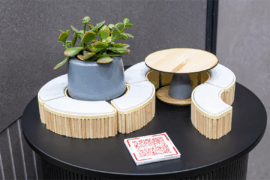
From the spark of an idea on the page to the launch of new pieces in a showroom is a journey every aspiring industrial and furnishing designer imagines making.
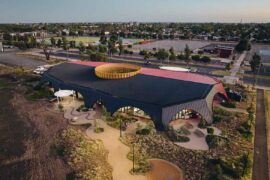
At the Munarra Centre for Regional Excellence on Yorta Yorta Country in Victoria, ARM Architecture and Milliken use PrintWorks™ technology to translate First Nations narratives into a layered, community-led floorscape.
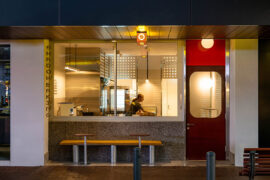
Working within a narrow, linear tenancy, Sans Arc has reconfigured the traditional circulation pathway, giving customers a front row seat to the theatre of Shadow Baking.

The Simple Living Passage marks the final project in the Simple World series by Jenchieh Hung + Kulthida Songkittipakdee of HAS design and research, transforming a retail walkway in Hefei into a reflective public space shaped by timber and movement.
The internet never sleeps! Here's the stuff you might have missed
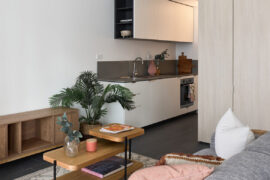
Boronia Apartments in Waterloo, designed by TURNER for City West Housing, delivers 74 affordable rental homes that combine sustainable design with long-term community-focused living.
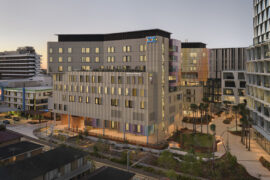
BLP’s new Sydney Children’s Hospital, Randwick building brings together paediatric care, family-centred design and Australia’s first Children’s Comprehensive Cancer Centre in a major addition to the Randwick Health & Innovation Precinct.